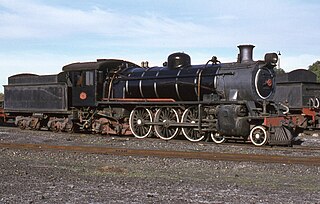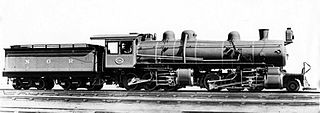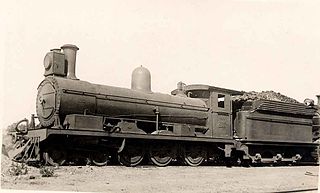
The valve gear of a steam engine is the mechanism that operates the inlet and exhaust valves to admit steam into the cylinder and allow exhaust steam to escape, respectively, at the correct points in the cycle. It can also serve as a reversing gear. It is sometimes referred to as the "motion".

Under the Whyte notation for the classification of steam locomotives by wheel arrangement, 4-10-2 represents the arrangement of four leading wheels, ten powered and coupled driving wheels and two trailing wheels. In South Africa, where the wheel arrangement was first used, the type was known as a Reid Tenwheeler. In the United States of America it was known as a Southern Pacific on the Southern Pacific Railroad and as an Overland on the Union Pacific Railroad.
A compound locomotive is a steam locomotive which is powered by a compound engine, a type of steam engine where steam is expanded in two or more stages. The locomotive was only one application of compounding. Two and three stages were used in ships, for example.

The South African Railways Class 5A 4-6-2 of 1903 was a steam locomotive from the pre-Union era in the Cape of Good Hope.

The South African Railways Class 5B 4-6-2 of 1904 was a steam locomotive from the pre-Union era in the Cape of Good Hope.

The South African Railways Class 5 4-6-2 of 1912 was a steam locomotive.

The South African Railways Class 4 4-8-2 of 1911 was a steam locomotive from the pre-Union era in the Cape of Good Hope.

The South African Railways Class Experimental 2 2-8-0 of 1902 was a steam locomotive from the pre-Union era in the Cape of Good Hope.

The South African Railways Class Experimental 3 2-8-0 of 1903 was a steam locomotive from the pre-Union era in the Cape of Good Hope.

The South African Railways Class MA 2-6-6-0 of 1909 was a steam locomotive from the pre-Union era in the Natal Colony.

The South African Railways Class MB 2-6-6-0 of 1910 was a articulated steam locomotive from the pre-Union era in the Colony of Natal.
The South African Railways Class MC 2-6-6-0 of 1912 was a steam locomotive.

The South African Railways Class MD 2-6-6-2 of 1910 was a steam locomotive from the pre-Union era in Transvaal.
The South African Railways Class ME 2-6-6-2 of 1912 was a steam locomotive.

The South African Railways Class MF 2-6-6-2 of 1911 was a steam locomotive from the pre-Union era in Transvaal.
The South African Railways Class MG 2-6-6-2 of 1911 was a steam locomotive from the pre-Union era in Transvaal.

The Central South African Railways Rack 4-6-4RT of 1905 was a South African steam locomotive from the pre-Union era in Transvaal Colony.

The South West African 2-8-0T of 1907 was a steam locomotive from the German South West Africa era.

The Cape Government Railways 3rd Class 4-4-0 of 1883 was a South African steam locomotive from the pre-Union era in the Cape of Good Hope.

The Cape Government Railways 5th Class 4-6-0 of 1891 was a South African steam locomotive from the pre-Union era in the Cape of Good Hope.

















